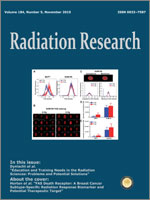The non-human primate has been a useful model for studies of human acute radiation syndrome (ARS). However, to date structural changes in various parts of the intestine after total body irradiation (TBI) have not been systematically studied in this model. Here we report on our current study of TBI-induced intestinal structural injury in the non-human primate after doses typically associated with hematopoietic ARS. Twenty-four non-human primates were divided into three groups: sham-irradiated control group; and total body cobalt-60 (60Co) 6.7 Gy gamma-irradiated group; and total body 60Co 7.4 Gy gamma-irradiated group. After animals were euthanized at day 4, 7 and 12 postirradiation, sections of small intestine (duodenum, proximal jejunum, distal jejunum and ileum) were collected and fixed in 10% formalin. The intestinal mucosal surface length, villus height and crypt depths were assessed by computer-assisted image analysis. Plasma citrulline levels were determined using liquid chromatography-tandem mass spectrometry (LC-MS/MS). Total bone marrow cells were counted and hematopoietic stem/progenitor cells in bone marrow were analyzed by flow cytometer. Histopathologically, all segments exhibited conspicuous disappearance of plicae circulares and prominent atrophy of crypts and villi. Intestinal mucosal surface length was significantly decreased in all intestinal segments on day 4, 7 and 12 after irradiation (P < 0.02–P < 0.001). Villus height was significantly reduced in all segments on day 4 and 7 (P = 0.02–0.005), whereas it had recovered by day 12 (P > 0.05). Crypt depth was also significantly reduced in all segments on day 4, 7 and 12 after irradiation (P < 0.04–P < 0.001). Plasma citrulline levels were dramatically reduced after irradiation, consistent with intestinal mucosal injury. Both 6.7 and 7.4 Gy TBI reduced total number of bone marrow cells. And further analysis showed that the number and function of CD45 CD34 hematopoietic stem/progenitors in bone marrow decreased significantly. In summary, TBI in the hematopoietic ARS dose range induces substantial intestinal injury in all segments of the small bowel. These findings underscore the importance of maintaining the mucosal barrier that separates the gut microbiome from the body's interior after TBI.
How to translate text using browser tools
21 October 2015
Total Body Irradiation in the “Hematopoietic” Dose Range Induces Substantial Intestinal Injury in Non-Human Primates
Junru Wang,
Lijian Shao,
Howard P. Hendrickson,
Liya Liu,
Jianhui Chang,
Yi Luo,
John Seng,
Mylene Pouliot,
Simon Authier,
Daohong Zhou,
William Allaben,
Martin Hauer-Jensen
ACCESS THE FULL ARTICLE

Radiation Research
Vol. 184 • No. 5
November 2015
Vol. 184 • No. 5
November 2015




